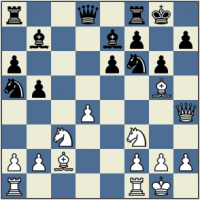
The Thematic d5-break in the Queen's Gambit Accepted by GM Magesh and GM Arun
This week we shall study the thematic break d4-d5 in the Queen's Gambit Accepted System. This break is very important in all Isolated pawn structures. The point is that after the d4-d5 break the position gets opened and the activity of the pieces matters most. White who leads in development constantly waits for the chance to get the d5-break in order to open up the position to utilize the underdeveloped opponent.
It is very important for the readers to study the isolated pawn structures very carefully since this structure can arise from different opening systems like QGA, Caro-Kann, Slav, Nimzo etc. Queen's Gambit Accepted is one opening where the isolated pawn structures occur frequently and we felt this would be an ideal place to show the readers some of the ideas behind this system; and to begin with we are starting off with d4-d5 thematic break.
Our first game is between Rodshtein and Diamant from the World Juniors 2009. Almost the whole game was already played and Black was caught unprepared for this system and was severely punished right in the opening. Let us see how White used the d5-break in this game.
That was a spectacular finish from the Young Israeli GrandMaster. The best chance for Black was to play 15. d5 Bxd5 instead of b4? which would have given a stiff resistance. Our next game is between Bacrot and Dominguez. Unlike our first game where white used the d5-break to launch an attack against the enemy king, this time White shows fantastic technique to crush Black for his small inaccuracy.
Instead of 13... b4 Black could have played Bb7 and Black was ok in the game Babula-Rublevsky. We hope that these examples show the readers the importance of guarding the d5-square for Black, since in most cases when white gets the d5-break there are good chances for the game to end in his favour. It's not just the d4-d5 break but also there are several ideas for White in these isolated pawn structures like Ne5,f4,f5 and also the h4-h5 plan a4-Ra3-Rg3 etc. For getting a good idea about these structures we recommend the readers to take a look at the Winning Pawn Structures book written by Baburin.





